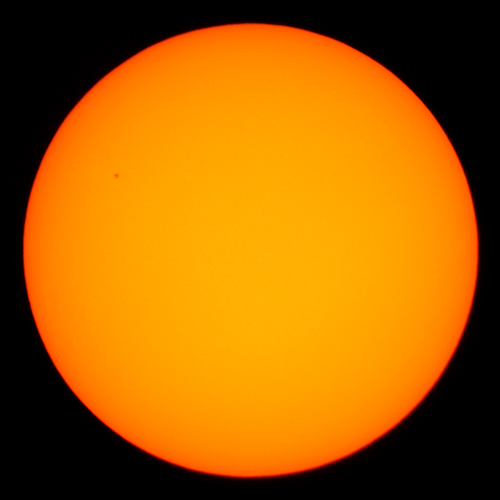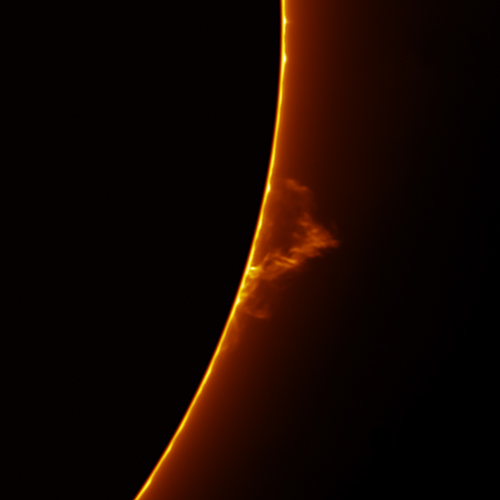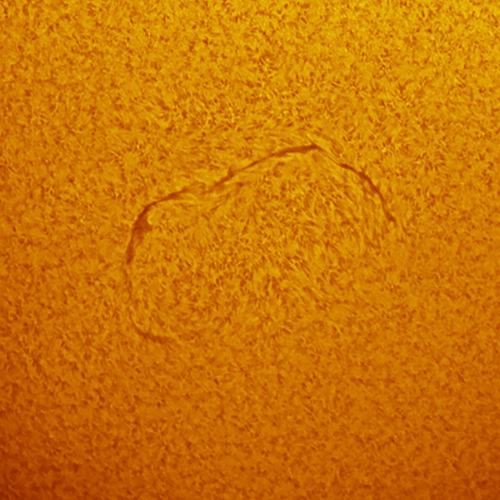A Brief Guide to The Sun
|
| |
The Sun is our nearest star. It is at the centre of the Solar System and is the major energy source fuelling life on Earth. Light takes just 8.3 minutes to reach Earth from the Sun. Strangely, a photon generated in the core of the Sun will travel about in the hot ball of plasma for over a million years before it finally makes it to the Sun's surface and starts its journey out into space. The Sun's diameter is about 1.39 million kilometres, enough to fit a little over 100 Earths. The Sun is busily converting its fuel reserve of hydrogen into helium through nuclear fusion. It is thought to be approximately 4.6 billion years old and about half way through its life. It is a pretty average G-type main sequence star, of spectral type G2V, referred to as a 'yellow dwarf', with a surface temperature of about 5700K. Eventually, as the hydrogen starts to run out, the core will begin to collapse while the outer layers will swell to make the Sun a red giant, filling the solar system beyond the orbits of Mercury and Venus, making life on Earth an impossibility. Ultimately the Sun will explode as a nova, shedding its outer material into space as a planetary nebula while the core will shrink to become a white dwarf.
The Sun is a fascinating and dynamic object that offers a wealth of imaging opportunities. The main features that appear in the images are explained here.
|
*** WARNING *** *** WARNING ***
NEVER look at the Sun through a telescope without appropriate filters and protection in place
|
| |
White Light
|

|
A white light image is created by collecting the full visible spectrum of light emitted by the Sun's photosphere. It is essential to ensure that the correct solar filters are in place before even considering pointing a telescope at the Sun. Don't forget to cover up the finderscope too! Generally the photosphere appears fairly smooth, though some slight granulation might be visible. The only features observed in white light are active regions, more commonly known as sun spots. In fact, there is a small active region visible in the image shown here. All the images I take of the Sun are in monochrome. They are coloured in post-production with the best approximation of the colour of the Sun.
|
| |
Hydrogen Alpha
|

|
It is possible to see the chromosphere of the Sun by using a hydrogen alpha filter. The chromosphere is the layer of the Sun above the photosphere, but within the corona. The hydrogen alpha filter in the Lunt solarscope that I use restricts transmitted light to the wavelength of 656nm, within 0.75 Angstroms. The detail that appears in hydrogen alpha is simply stunning. The most obvious feature is the granulation across the whole surface of the Sun. You are looking at the tops of the plasma columns created by convection currents, rising up from the core of the Sun. The rising part of the plasma is bright in the centre, with darker edges where the plasma is descending back in to the Sun.
|
| |
Active Regions
|

|
Active regions, or sun spots, show as dark patches on the Sun's surface. They are cooler than their surrounding area and appear darker to us, though they are still white hot! Sun spots develop due to magnetic field flux that inhibits the convection of the plasma columns. They usually appear in pairs of opposite magnetic polarity. Sunspots are temporary phenomena, lasting from a few days to a few months. They are dynamic regions that are in constant change and make for fascinating images. It is possible to see a darker central portion known as the 'umbra', with a slightly lighter surrounding area called the 'penumbra'. The lightest, almost white, areas around the sun spots are called 'plages'.
|
| |
Prominences
|

|
A prominence is a large, bright, gaseous feature extending outward from the Sun's surface, often in a loop shape. Prominences are anchored to the Sun's surface in the photosphere and extend outwards into the Sun's corona. While the corona consists of extremely hot ionized gases, known as plasma, which do not emit much visible light, prominences contain much cooler plasma, similar in composition to that of the chromosphere. The prominence plasma is typically a hundred times more lit and denser than the coronal plasma. A prominence forms over timescales of about a day and may persist in the corona for several weeks or months, looping hundreds of thousands of miles into space.
|
| |
Filaments
|

|
What do you call a prominence when it is over the Sun's surface rather than at the edge or limb? A filament! They are dark lines across the surface of the Sun's disk. In reality they are of course reaching out towards us above the surface of the Sun. They create majestic shapes that are beautifully photogenic. It is even possible to have a 'fila-prom' when a filament extends across the Sun's surface, reaching the limb and continues out into the corona as a prominence. Some prominences break apart and may then give rise to coronal mass ejections.
|
| |
|





